Key Takeaways
- Use the Search Results Performance Report in GSC to view keyword rankings.
- Turn on the Average Position toggle to see query and page rankings.
- Average Position is a mean value based on where your site appears in the SERPs.
- GSC shows real user search data, not live rankings.
- Other tools like Ahrefs give snapshot rankings and track competitors.
- GSC is limited to your verified properties only.
- GSC does not show keywords you haven’t appeared for.
- Data is sampled for large sites and may not be exact.
- Reporting is delayed by one to three days in Google Search Console.
- Only sixteen months of data is stored in Google Search Console.
- You can filter by country or device, but not by city.
- GSC does not offer live rank tracking.
- For deeper insights, use tools like SEOTesting’s Rank Tracker, Ahrefs, or Semrush.
Table of Contents
- How to Track Keyword Ranking in Google Search Console
- What Does Average Position Mean in Google Search Console
- How is Google Search Console Different from Other Rank Tracking Tools
- Limitations to Keyword Tracking in Google Search Console
- Frequently Asked Questions
How to Track Keyword Ranking in Google Search Console
To track your keyword rankings in Google Search Console, start on your Google Search Console Dashboard:
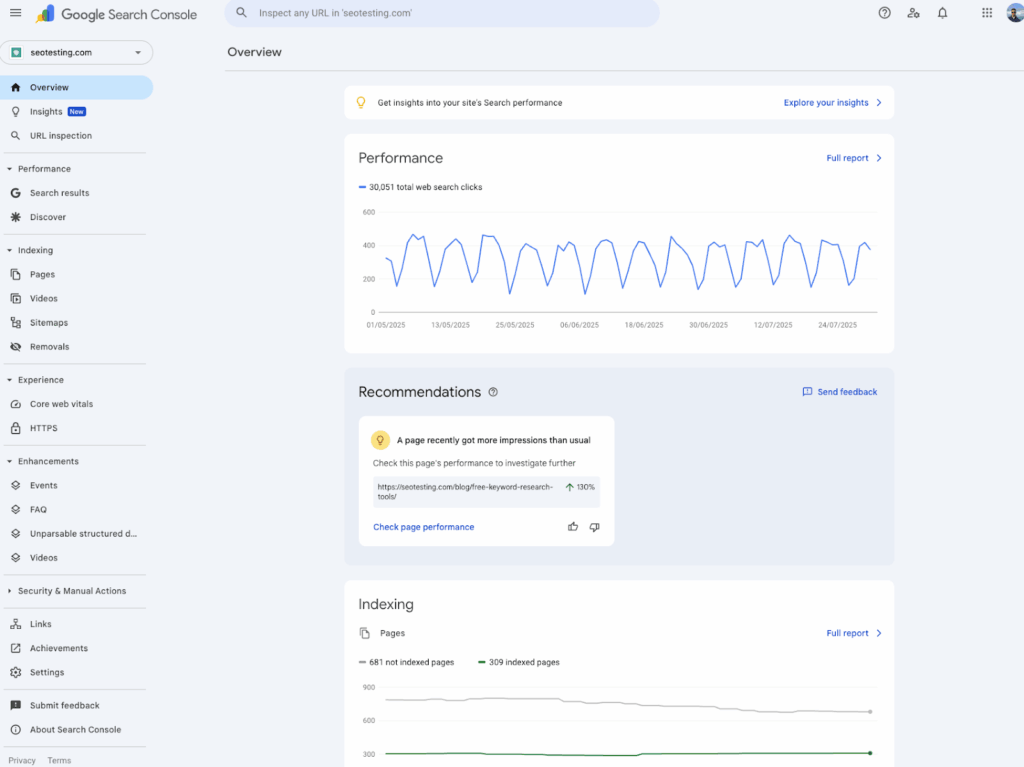
Click on the “Search results” listing in the “Performance” section of the toolbar on the left-hand side of your screen:
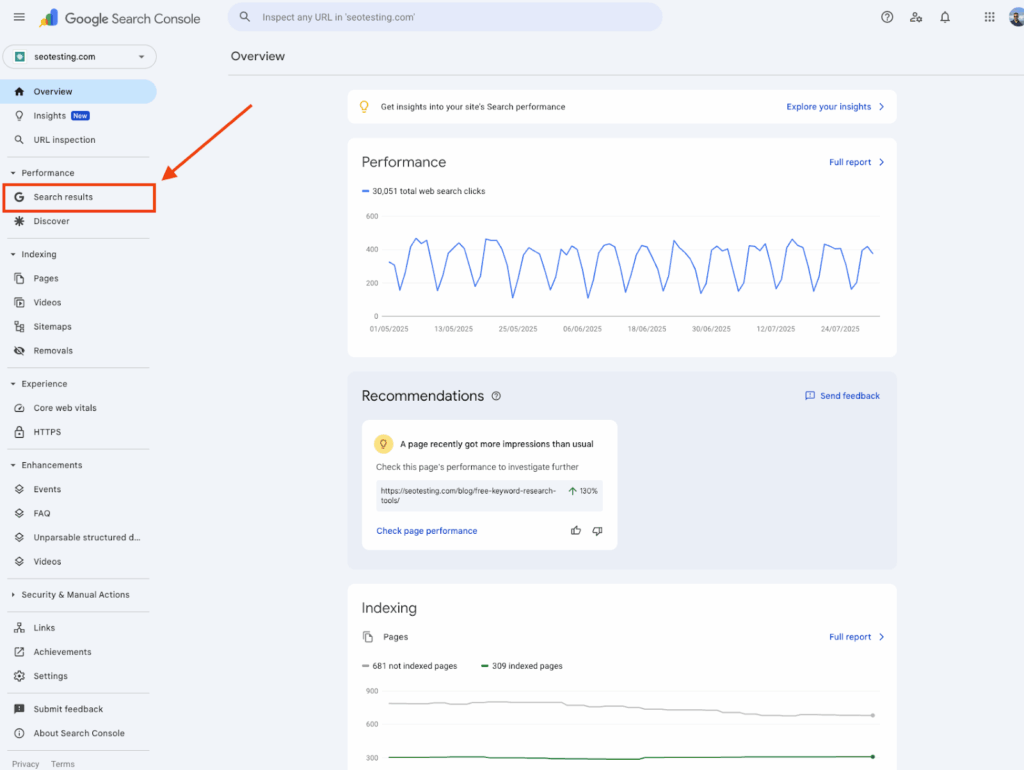
Scroll down the page so you can see the list of queries that are available on your Search Results Performance Report:
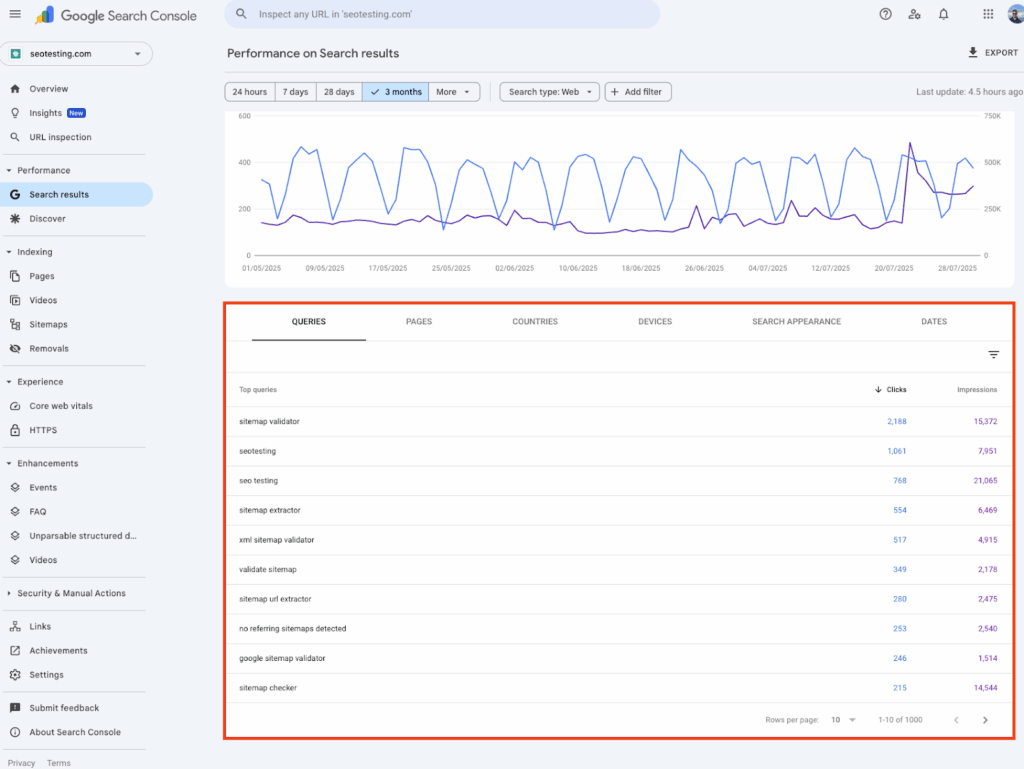
Click on the “Average position” toggle above the performance graph:
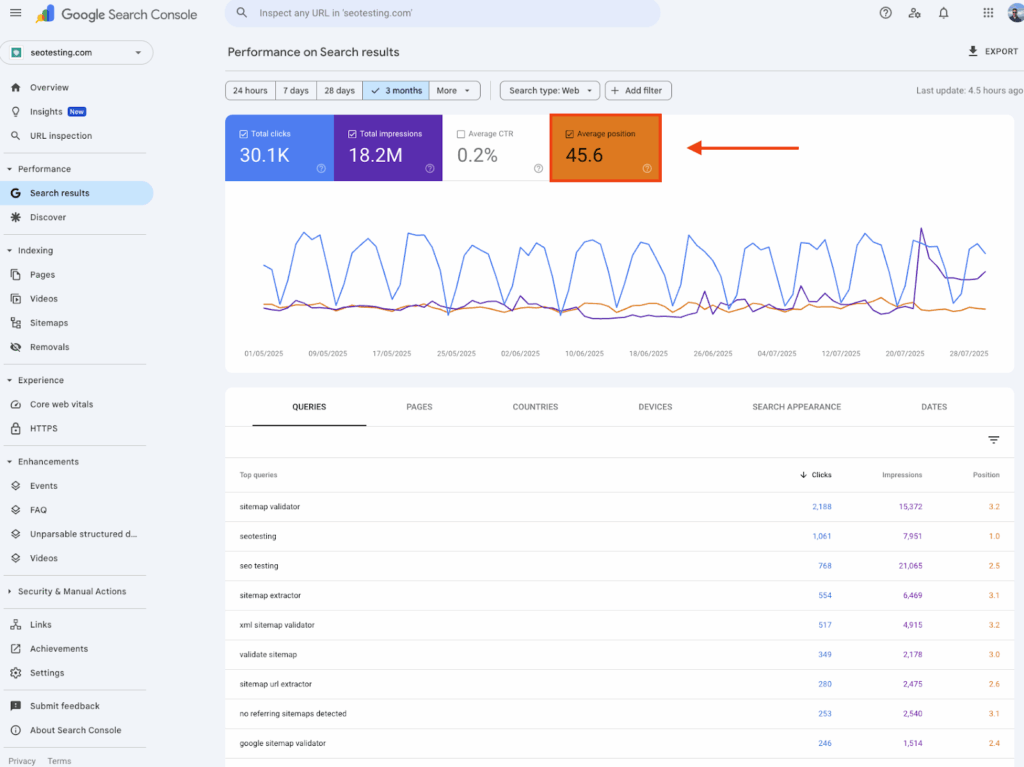
This will bring up a line showing your average position, but more importantly, it will then show each query’s average position on the table:
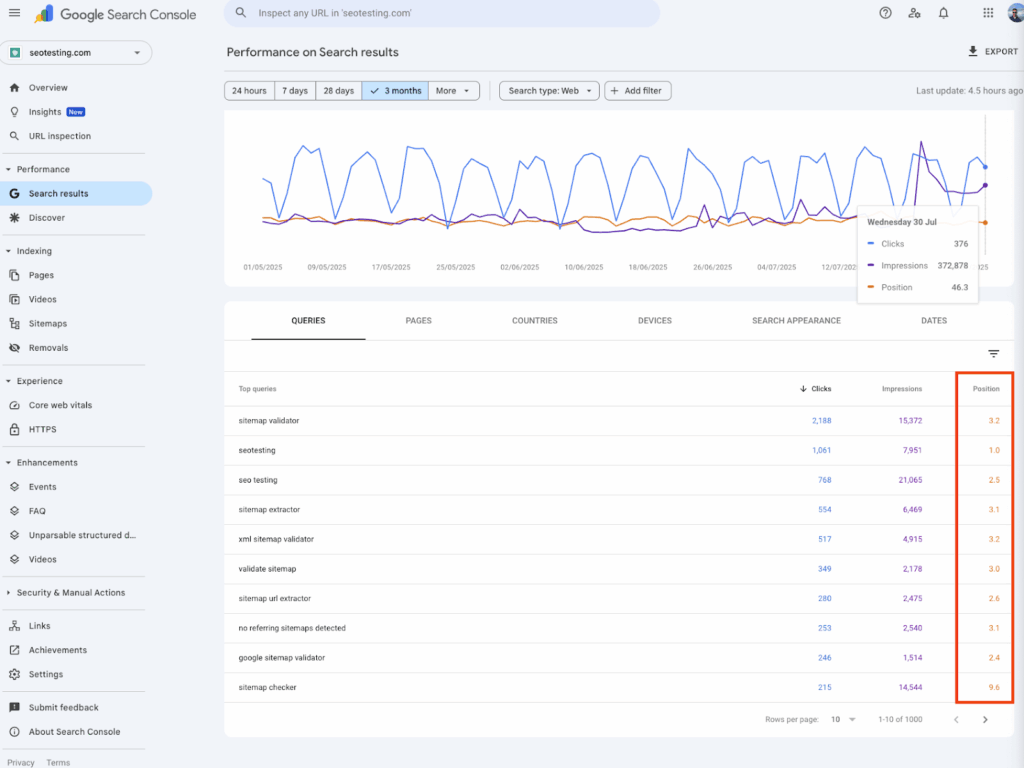
You can also click “Pages” and you will be shown a list of your website’s URLs along with the average position for each of those URLs:
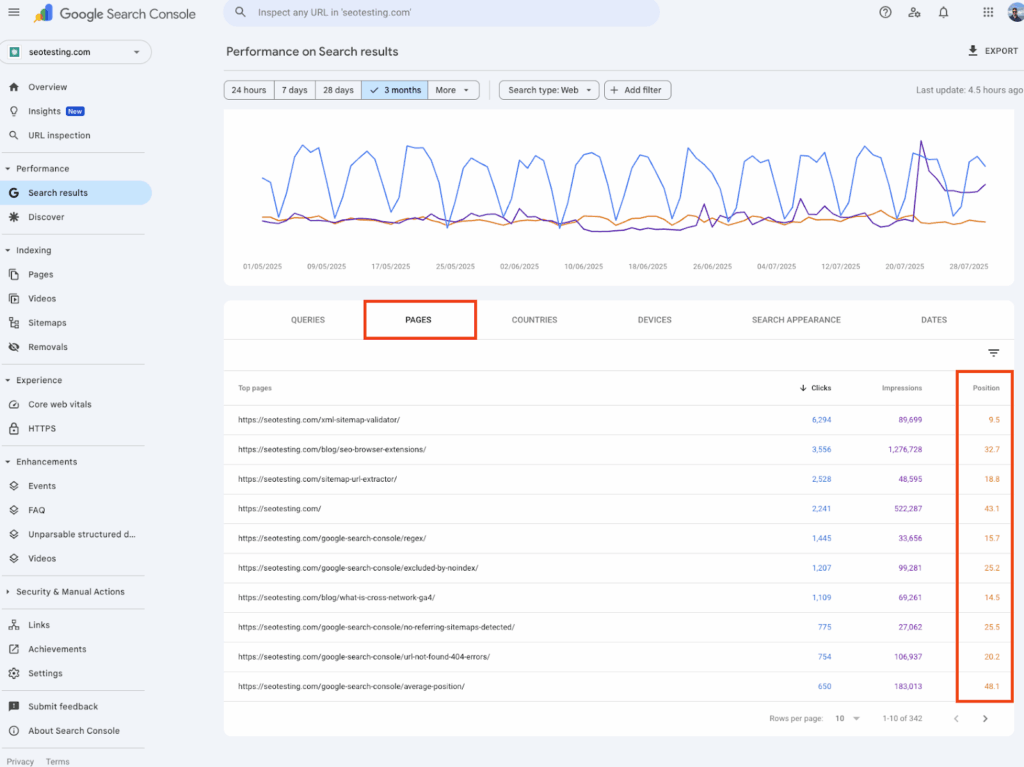
What Does Average Position Mean in Google Search Console?
The Average Position metric in Google Search Console shows the average (mean) ranking of your website on the SERPs for a specific query or page over a given period of time.
Google calculates this by taking the highest position your site appears for each search (if your site appears in multiple positions, anyway) and averages it out across all your impressions.
For example:
If your site ranks at Position 2 and Position 5 for the same query in one search, Google counts Position 2. If another search shows you at Position 4, then your average position would be 3.
This metric is most reliable when viewed at the query level for pages with decent impression volumes. Low-impression queries can show fluctuating averages due to different things, like personalization and localization.
If you want to learn more about the Average Position metric in Google Search Console, check out our Average Position Guide.
If you want to get more use out of Google Search Console’s Average Position, give SEOTesting’s Rank Tracker a try. We take your Average Position and keep hold of it so we can give you more information over time:
![]()
How is Google Search Console Different from Other Rank Tracking Tools?
It’s important to understand that Google Search Console tracks rankings differently from most rank tracking tools.
Whilst Google Search Console uses the average position metric to give users a broader sense of where they rank for different queries and where their pages rank on average, other rank tracking tools often take a ‘snapshot’ of a SERP for any given query and use that to give you a rank.
Let’s look at Ahrefs, for example:
Their ‘Keywords Explorer’ allows me to input a query I want to look at, and a location I want to examine it in:
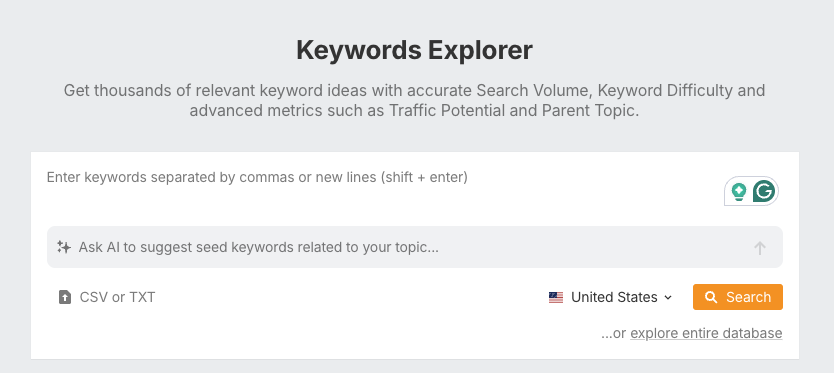
So if I were to search for “SEO Testing” in the United States, the results I’d get would be based on Ahrefs looking at the SERP for “SEO Testing” in the US and looking where different websites rank, which you can see further down the report:
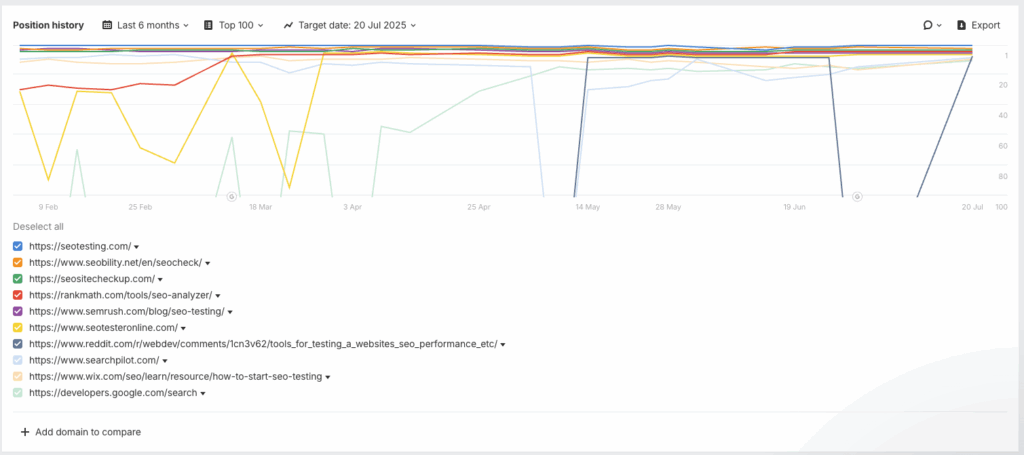
I can also do this on a per-site basis. If I examine the SEOTesting website within Ahrefs, I can get a keyword overview of where we rank for many different keywords in different locations:
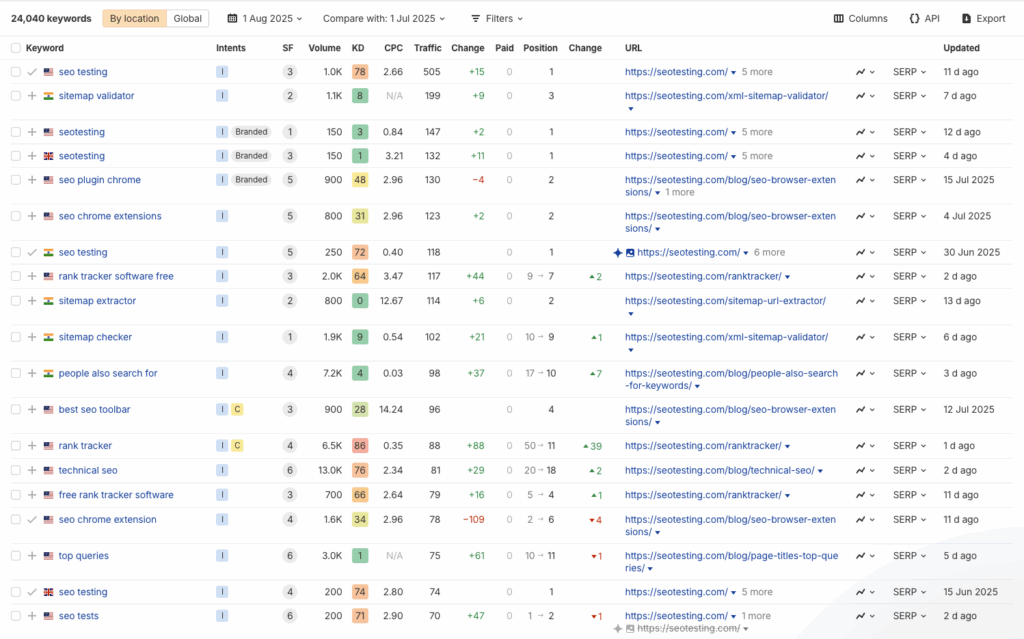
Mainstream tools like Ahrefs and Semrush use their own crawlers to scan search results directly. They take regular snapshots of the SERPs for specific keywords in different locations.
This means they can show data for any keyword, even if your site has never appeared for it. And it also lets you track competitors and monitor search results across different markets.
That gives you a broader and more complete view of the state of SEO in your niche. In that sense, the data feels a lot more well-rounded because it’s not limited to your own site’s impressions or clicks like Google Search Console.
Limitations to Keyword Tracking in Google Search Console
There is no doubt that Google Search Console is a great free resource if you lack the budget for a paid rank tracking tool. However, there are some limitations you should be aware of.
Data Sampling in Google Search Console
It’s well known that Google uses data sampling for websites that get a large amount of traffic from Google. This means the data you see might not 100% represent your actual search performance.
For smaller sites, this isn’t going to be much of an issue, but larger sites may find that their reported metrics are estimates rather than exact figures.
This sampling can make it difficult to track small changes in ranking performance, or find subtle trends in your data.
Delayed Reporting
Google Search Console does not offer real-time reporting. You still cannot see what’s happening on your site instantly.
In the past, you’d have to wait one to three days to see any data. Now, there is a 24-hour filter that gives you access to more recent information.
This helps you check early signs of impact after changes. It also helps you catch ranking drops sooner. But the data still lags behind real-time. So while it’s a big improvement, you still need to wait a little bit before drawing any firm conclusions.
For any SEO campaigns you’re running that are time-sensitive or in a competitive market, I’d highly recommend investing in an SEO suite (like Ahrefs or Semrush) that has built-in rank tracking, or investing in a specialist rank tracking tool.
Limited Historical Data
It’s well known at this point that Google Search Console only stores 16 months of data for your websites. This limits your ability to analyze long-term trends or seasonal patterns in your keyword ranking performance.
If you need to track year-on-year changes or analyze historical ranking patterns, you’ll need to export and store data manually.
Alternatively, you can use a tool like SEOTesting, which automatically archives your Google Search Console data from the moment you sign up.
Instead of losing valuable insights after 16 months, you’ll have a complete record of your site’s performance to look back on. This makes it easier to analyze the impact of past SEO changes, spot seasonal patterns, and identify long-term trends that would otherwise be lost.
This won’t help with active rank tracking, but it does certainly get around one of Google Search Console’s main limitations.
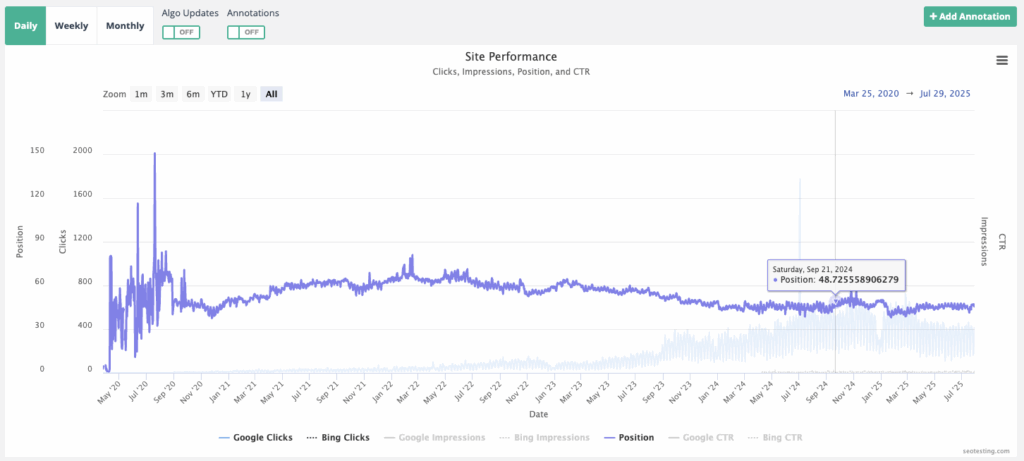
Country/Device Filtering
Google Search Console offers some geographic and device filtering options, but these are not as granular as those found in specialized rank tracking tools.
You can filter your data by country and device type, but not track rankings for specific regions or cities. This is, obviously, a crucial part of local SEO campaigns, especially so if you are running lots of local campaigns; you will need to invest in a rank tracking tool that allows you to track rankings for the regions you are specifically targeting.
No Live Rank Tracking
Google Search Console shows your site’s performance over time (limited to the last 16 months as talked about before). But it does not offer live ranking updates.
You can’t see where you rank right now for a keyword. You can only see where you’ve ranked on average over a selected time period. This is different to a tool like Ahrefs, where we can see where we rank and when that ranking was last updated:
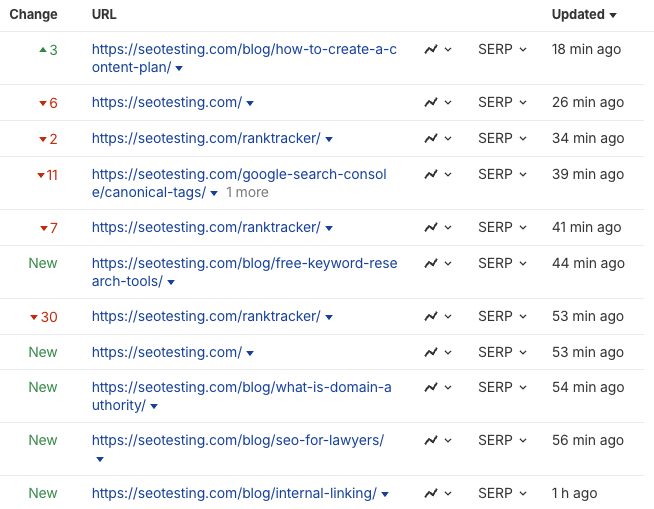
The new 24-hour filter helps you spot changes faster than before. But the data still lags behind real-time. So it’s useful for trend tracking, not for live rank checking.
This makes it challenging to track immediate changes from the SEO tasks you perform on a daily, weekly, and monthly basis.
Queries Tied to Property
Google Search Console only shows query data for websites you’ve verified and have added as properties. On top of that, it only shows queries where your site has received impressions or clicks.
This means you won’t see keyword data for terms your site hasn’t appeared for yet. You also can’t explore competitor data or broader keyword trends like you can in a tool such as Ahrefs or Semrush.
That makes it harder to find new opportunities or get a full picture of your niche using GSC alone.
Frequently Asked Questions
How often does Google Search Console update keyword ranking data?
Google Search Console typically updates its data every 1-3 days. The exact timing can vary, and some data may take longer to appear, especially for newer websites or less frequently crawled pages.
Can I track competitor keyword rankings in Google Search Console?
No. Google Search Console will only show data for the websites in your account that you own and that you have verified. If you want to track competitor rankings, you will need to use a specialized rank tracker included within an SEO suite like Ahrefs or Semrush.
Why don’t I see all my target keywords in Google Search Console?
GSC only displays queries that generated impressions (your site appeared in search results) or clicks. If you don’t rank high enough for a keyword to appear in search results, or if the keyword doesn’t generate any impressions, it won’t appear in your GSC data.
Is the Average Position metric in GSC accurate?
Average Position is generally accurate for the data it represents, but it’s an average over time rather than a current ranking. It reflects how your site has performed over the selected date range, not necessarily where you rank at this moment.
How far back can I view keyword ranking data in Google Search Console?
Google Search Console keeps its data for sixteen months. Once that time has passed, all of its data is automatically deleted and cannot be recovered. So if you are going to be needing this data for your analysis, you will need to export it all.
Google Search Console is a great tool for tracking keyword rankings if you understand how it works. It gives you average position data tied to real searches. But it also comes with limits like data delays and no live tracking.
For basic SEO work or when budgets are tight it does the job well. But if you need real-time data or want to track competitors and new keywords then a paid tool may be better.
Tired of Google Search Console’s limitations? Give SEOTesting a try! We’ve got a 14-day free trial you can take advantage of, and there’s no credit card needed for you to sign up. Start your free trial today.


